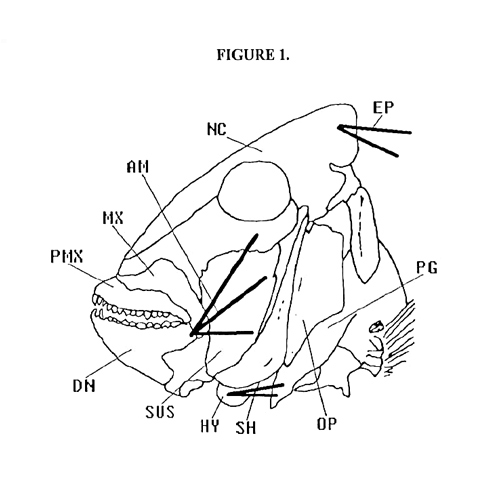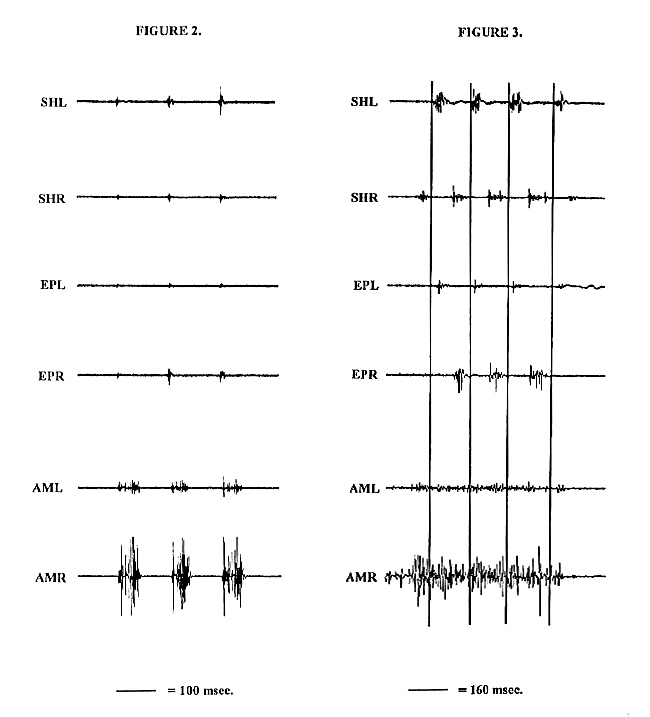
For reals. Lagodon rhomboides. And I quote myself: "This is the first analysis of a possible prey type effect on the degree of bilaterally symmetric and asymmetric modulation of the feeding motor patterns in a lower vertebrate." This is my undergraduate 'Honors in the Major' research thesis made while studying biology (with with an emphasis on ecology and evolution) at Florida State University. Here is a pdf version of my thesis recently found in the Florida Center for Library Automation archives. After graduation I had my paper professionally bound and I submitted it to the FSU library. Figure 1 above is my oldest surviving digitally produced image, handmade in 1994 using Corel Draw on a Windows 3.11 PC. (my digital work dates back to about 1978, all lost)
The breakdown (or at least how I remember it): The bones and muscles in the mouths of fishes are mechanically the most complex structures in the animal kingdom. Unsurprisingly then one finds an incredible amount of diversity in buccal structure and function. Fishes have been swimming around a looooooong time on this planet, yes? They have evolved to use their mouths for all sorts of particular things related to feeding, breathing, defense, locomotion, etc. This creates plenty of scientific opportunity for functional morphologists - those who study biological structures and functions, often with the goal of deducing evolutionary relationships. The members of the laboratory I apprenticed in studied primarily triggerfish and blowfish. Explore the order Tetrodontiformes. Or perhaps the family Tetraodontidae. For my own project I could have gone with one of these, maybe should have, but I have a weakness for uniqueness. When going to the Florida panhandle coast trying to catch/discover exciting fish to possibly research for my thesis project, I kept catching Pinfish. These are small, unglamorous creatures. No one really fishes for or even observes them - they are rather plain looking and just sit there in hordes, stealing the bait which you've just purchased... squid, shrimp, crab, anything. And they're everywhere. I reasoned that their overabundance and aggressive, generalist feeding behavior might be something to investigate. But Wainwright's lab was all about feeding specialization not generalization! Well I'm just a punk. A few of the undergrads/postgrads in the lab laughed at my choice of the lowly Pinfish. I stood my ground.
Captured specimens were fed various types of food after being anesthetized and electrode implanted (forever sorry little dudes!). The behavior of the main feeding muscles were then quantified, in keeping with the standards of the laboratory's materials and methods. In the end the only thing I was able to statistically conclude from the data was that certain prey types elicited a bilaterally symmetric muscle response, while others an asymmetric one. To paraphrase: they would just chomp down on stuff like shrimp pieces, but a big hunk of something like squid would cause a side-to-side head thrashing to get the job done. WHOA! I guess that had never before been proven through science, and the ramifications of this discovery are still today yet unknown. Figures 2 and 3 below are the electromyographs showing symmetric, then asymmetic muscle activity. The muscles, as also depicted in Figure 1 above, are the sternohyoideus left and right (throat region), epaxialis left and right (top of head), and adductor mandibulae (jaws).

My heart goes out to all the under-appreciated but beautiful Pinfish of the world, as well as to a couple functional morphologists who were generous and helped me out in many ways. If only they knew they were getting involved with a crazed career collector they might have acted differently :) Peter Wainwright and Ralph Turingan. Both top notch scientists, artists. View some of Peter's incredible 500 fps fish feedings that are so fast youtube can barely render them! Fond memories of making similar high speed videos as his lab assistant, and using software to draw geometric objects on each frame for kinetics calculations. Blew my mind.